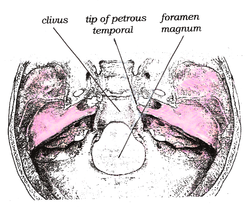Clivus (anatomy)
| Clivus | |
|---|---|
 Superior view of the clivus | |
| Details | |
| Identifiers | |
| Latin | Clivus |
| TA98 | A02.1.00.051 A02.1.04.006 |
| TA2 | 454 |
| FMA | 54376 |
| Anatomical terms of bone | |
The clivus (/ˈklaɪvəs/,[1] Latin for "slope"), or Blumenbach clivus, is a bony[2] part of the cranium at the base of the skull. It is a shallow depression behind the dorsum sellae of the sphenoid bone. It slopes gradually to the anterior part of the basilar occipital bone at its junction with the sphenoid bone. It extends to the foramen magnum. It is related to the pons and the abducens nerve (CN VI).
Structure[]
The clivus is a shallow depression behind the dorsum sellae of the sphenoid bone.[3] It slopes gradually to the anterior part of the basilar occipital bone at its junction with the sphenoid bone. It extends to the foramen magnum.[3] On axial planes, it sits just posterior to the sphenoid sinuses. It is medial to the foramen lacerum (the internal carotid artery reaches the middle cranial fossa above the foramen lacerum), proximal to its anastomosis with the Circle of Willis. It is anterior to the basilar artery.
The pons sits on the clivus.[3] The abducens nerve (CN VI) also tracks along the clivus during its course.[3]
Clinical importance[]
The abducens nerve (CN VI) tracks along the clivus during its course.[3] Increased intracranial pressure can trap the nerve at this point and cause signs of palsy.
The clivus is also the site for chordoma, a rare type of cancer.
Surgery[]
Surgery for lesions involving the clivus and surrounding structures have traditionally been approached via extended subfrontal transbasal, anterior transfacial, lateral transtemporal, far-lateral approaches, and staged approaches.[4] These approaches are limited in that they often require extensive bone removal and brain retraction while placing critical neurovascular structures between the surgeon and the site of pathology. It has been proposed that these limitations are mitigated by significant advancements in the use of endoscopic endonasal surgery. Contemporary surgical approaches involving extended endoscopic endonasal approaches to the clivus have been increasingly described by several groups, and have been shown to be a safe and effective strategy for the surgical management of a variety of benign and malignant lesions.[4]
Relation of the clivus and dens[]
The clivus is an important landmark for checking for anatomical atlanto-occipital alignment. Wheen viewed on a lateral C-spine radiograph, the clivus forms a line which, if extended, is known as Wackenheim's clivus line. Wackenheim's clivus line should pass through the dens of the axis or be tangential to it.[5]
History[]
"Clivus" is also used as an abbreviated term for the clivus ocularis, which is the sloping inner wall of the retina as it dips into the foveola in the macula of the eye. To disambiguate, the clivus is sometimes referred to as the Blumenbach clivus. This is named after Johann Friedrich Blumenbach.[citation needed]
Additional images[]
Clivus
Clivus
See also[]
References[]
![]() This article incorporates text in the public domain from page 148 of the 20th edition of Gray's Anatomy (1918)
This article incorporates text in the public domain from page 148 of the 20th edition of Gray's Anatomy (1918)
- ^ "Definition of clivus | Dictionary.com". www.dictionary.com. Retrieved 2022-01-05.
- ^ Drake, Richard L. Gray's Anatomy for Students 3rd Ed. p. 868.
- ^ a b c d e Maira, Giulio; Doglietto, Francesco; Pallini, Roberto (2012). "41 - Surgical Management of Lesions of the Clivus". Schmidek and Sweet Operative Neurosurgical Techniques (6th ed.). Saunders. pp. 486–500. doi:10.1016/B978-1-4160-6839-6.10041-3. ISBN 978-1-4160-6839-6.
- ^ a b Little, Ryan E.; Taylor, Robert J.; Miller, Justin D.; Ambrose, Emily C.; Germanwala, Anand V.; Sasaki-Adams, Deanna M.; Ewend, Matthew G.; Zanation, Adam M. (August 2014). "Endoscopic endonasal transclival approaches: case series and outcomes for different clival regions". Journal of Neurological Surgery. Part B, Skull Base. 75 (4): 247–254. doi:10.1055/s-0034-1371522. ISSN 2193-6331. PMC 4108492. PMID 25093148.
- ^ McKenna DA, Roche CJ, Lee KW, Torreggiani WC, Duddalwar VA. Atlanto-occipital dislocation: case report and discussion. Can J Emerg Med 2006; 8(1):50-3. Available at: link Archived 2007-09-27 at the Wayback Machine and link Archived 2007-09-27 at the Wayback Machine. Accessed on: December 7, 2006.
External links[]
- Anatomy photo:22:os-0913 at the SUNY Downstate Medical Center - "Osteology of the Skull: Internal Surface of Skull"
- Diagram at uwo.ca
- Wikipedia articles incorporating text from the 20th edition of Gray's Anatomy (1918)
- Musculoskeletal system stubs
- Bones of the head and neck

